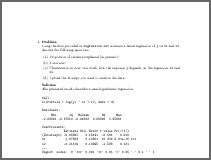essayreg2: Linear Regression (Cloze with Essay and File Upload)
essayreg2Using the data provided in regression.csv estimate a linear regression of y on x1 and x2. Answer the following questions.
Proportion of variance explained (in percent):
F-statistic:
Characterize in your own words how the response y depends on the regressors x1 and x2.
Upload the R script you used to analyze the data.
The presented results describe a semi-logarithmic regression.
Call:
lm(formula = log(y) ~ x1 + x2, data = d)
Residuals:
Min 1Q Median 3Q Max
-2.68802 -0.67816 -0.01803 0.68866 2.35064
Coefficients:
Estimate Std. Error t value Pr(>|t|)
(Intercept) -0.06802 0.13491 -0.504 0.616
x1 1.37863 0.13351 10.326 9.34e-15
x2 -0.21449 0.13995 -1.533 0.131
Residual standard error: 1.052 on 58 degrees of freedom
Multiple R-squared: 0.6511, Adjusted R-squared: 0.6391
F-statistic: 54.12 on 2 and 58 DF, p-value: 5.472e-14The mean of the response y increases with increasing x1. If x1 increases by 1 unit then a change of y by about 296.94 percent can be expected. Also, the effect of x1 is significant at the 5 percent level.
Variable x2 has no significant influence on the response at 5 percent level.
The R-squared is 0.6511 and thus 65.11 percent of the variance of the response is explained by the regression.
The F-statistic is 54.12.
- Proportion of variance explained: 65.11 percent.
- F-statistic: 54.12.
- Characterization: semi-logarithmic.
- R code.
Using the data provided in regression.csv estimate a linear regression of y on x1 and x2. Answer the following questions.
Proportion of variance explained (in percent):
F-statistic:
Characterize in your own words how the response y depends on the regressors x1 and x2.
Upload the R script you used to analyze the data.
The presented results describe a log-log regression.
Call:
lm(formula = log(y) ~ log(x1) + log(x2), data = d)
Residuals:
Min 1Q Median 3Q Max
-1.2455 -0.2693 -0.0071 0.2339 0.9976
Coefficients:
Estimate Std. Error t value Pr(>|t|)
(Intercept) -0.01096 0.04900 -0.224 0.824
log(x1) 0.96949 0.04432 21.875 <2e-16
log(x2) 0.02591 0.05341 0.485 0.629
Residual standard error: 0.447 on 81 degrees of freedom
Multiple R-squared: 0.8555, Adjusted R-squared: 0.8519
F-statistic: 239.8 on 2 and 81 DF, p-value: < 2.2e-16The mean of the response y increases with increasing x1. If x1 increases by 1 percent then a change of y by about 0.97 percent can be expected. Also, the effect of x1 is significant at the 5 percent level.
Variable x2 has no significant influence on the response at 5 percent level.
The R-squared is 0.8555 and thus 85.55 percent of the variance of the response is explained by the regression.
The F-statistic is 239.78.
- Proportion of variance explained: 85.55 percent.
- F-statistic: 239.78.
- Characterization: log-log.
- R code.
Using the data provided in regression.csv estimate a linear regression of y on x1 and x2. Answer the following questions.
Proportion of variance explained (in percent):
F-statistic:
Characterize in your own words how the response y depends on the regressors x1 and x2.
Upload the R script you used to analyze the data.
The presented results describe a log-log regression.
Call:
lm(formula = log(y) ~ log(x1) + log(x2), data = d)
Residuals:
Min 1Q Median 3Q Max
-0.90603 -0.25642 -0.01465 0.21672 1.25306
Coefficients:
Estimate Std. Error t value Pr(>|t|)
(Intercept) 0.07904 0.06266 1.261 0.213
log(x1) -0.82335 0.06078 -13.547 <2e-16
log(x2) -0.03764 0.06424 -0.586 0.560
Residual standard error: 0.4479 on 54 degrees of freedom
Multiple R-squared: 0.7784, Adjusted R-squared: 0.7702
F-statistic: 94.85 on 2 and 54 DF, p-value: < 2.2e-16The mean of the response y decreases with increasing x1. If x1 increases by 1 percent then a change of y by about -0.82 percent can be expected. Also, the effect of x1 is significant at the 5 percent level.
Variable x2 has no significant influence on the response at 5 percent level.
The R-squared is 0.7784 and thus 77.84 percent of the variance of the response is explained by the regression.
The F-statistic is 94.85.
- Proportion of variance explained: 77.84 percent.
- F-statistic: 94.85.
- Characterization: log-log.
- R code.
Demo code:
library("exams")
set.seed(403)
exams2html("essayreg2.Rmd")
set.seed(403)
exams2pdf("essayreg2.Rmd")
set.seed(403)
exams2html("essayreg2.Rnw")
set.seed(403)
exams2pdf("essayreg2.Rnw")


